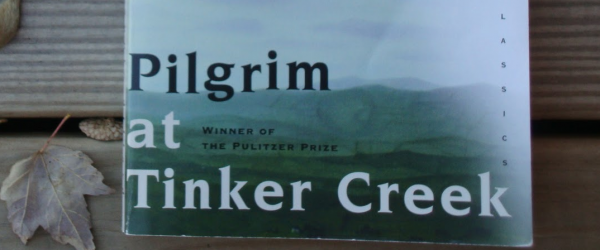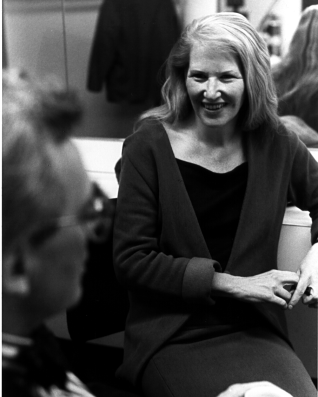
Blinded By The Light: Pilgrim at Tinker Creek
Books, ReviewsAnnie Dillard’s “Pilgrim at Tinker Creek” Dares Us To Open Our Eyes

When I was ten or eleven years old I went bulldozing through the newfallen leaves in the creekbed behind my house and stumbled upon a burning bush, alive with thousands of Monarch butterflies, flapping and guttering as with flame. The Monarchs didn’t like my crashing their party, though, and exploded from the branches with a violent beating of wings. As quickly as they had appeared, they were gone, just like that. I couldn’t breathe. It was a once-in-a-lifetime experience, a sight I still find myself dreaming about, nearly thirty years on.
In her Pulitzer Prize-winning treatise on nature, Pilgrim at Tinker Creek, author Annie Dillard manages to see something equally breathtaking, nearly every day of the week. The essays here are, as Eudora Welty writes on the blurb, “a form of meditation, written with headlong urgency, about seeing.”
When I came upon the burning bush in my own creekbed, I did not understand at the time that I was witnessing the annual migration south of the Monarch butterfly. It was only later, in biology class, that I connected the teacher’s lesson plan to the vision I’d witnessed, and finally knew what I had seen. Dillard does much the same thing in her book, stationing herself in a stream or a field, hoping to capture some mystical image on the photoplate of her mind’s eye. Then she rushes home to her cabin on Tinker Creek, in Virginia’s Blue Ridge mountains, and hits the books, doing her level best to understand the science behind, history of, and meaning implied by these fleeting spectacles, “the live water and light that bears from undisclosed sources the freshest news, renewed and renewing, world without end.”

Annie Dillard
Dillard is trying to open the reader’s own eyes to the divinity implied by the intricacy of this natural world. The author presents her argument in two distinct parts, told over the course of a single calendar year. We begin with winter, and a building amazement at the joy that is creation. We learn seemingly trivial details: how Eskimos bury a knife slathered in frozen seal blubber, then lie in wait for a wolf to “lick it compulsively with numbed tongue, until he sliced his tongue to ribbons, and bled to death”; how some clouds can be seen reflected in water, but are invisible in the sky, because “polarized light from the sky is very much weakened by reflection, but the light in clouds isn’t polarized”; how “the sense impression of one-celled animals are not edited for the brain,” which gives birth to an interesting philosophical conundrum, “since it means that only the simplest animals perceive the universe as it is.”
But these aren’t trivial facts. One of Dillard’s key points is that, unless you understand what it is you’ve seen, you haven’t seen it. “You get what you see,” is her mission statement, and she wants us to see it all. With humor, compassion, and grace, she impresses upon the reader the importance of faith … in God, Buddha, Muhammad, Yahweh. Whatever you want to call it, it’s out there, she argues, ready and waiting to change your life, if you’ll let it.
After spending the first half of her book acting as a kind of ecstatic safari guide, building up the reader’s amazement at the interconnectedness of all things, the author shifts into a more introspective gear. In the afterward to the twenty-fifth anniversary edition, Dillard says of the book’s two-part structure:
Running the story through a year’s seasons was conventional, so I resisted it, but since each of the dozen alternative structures I proposed injured, usually fatally, the already frail narrative, I was stuck with it. The book’s other, two-part structure interested me more. Neoplatonic Christianity described two routes to God: the via positiva and the via negativa. Philosophers on the via positiva assert that God is omnipotent, omniscient, etc; that God possesses all positive attributes. I found the via negativa more congenial. Its seasoned travelers (Gregory of Nyssa in the fourth century and Pseudo-Dionysius in the sixth) stressed God’s unknowability. Anything we may say of God is untrue, as we can know only creaturely attributes, which do not apply to God. Thinkers on the via negativa jettisoned everything that was not God; they hoped that what was left would be only the divine dark.
Every argument has two sides, and like any good philosopher or scientist, Dillard examines the flip side to awe. In part two, the author begins to deconstruct the sense of joy she’s built up, and investigates the complex interweavings between life and death, joy and sorrow, beauty and pain. We learn of parasites and snakes, injury and deformation, sickness, plague, and death. Dillard reveals an absurd irony: evolution, which enables and sustains life, depends upon death as a kind of macabre fuel to ensure that future versions of us can keep kicking, and wondering why we’re here:
The faster death goes, the faster evolution goes. If an aphid lays a million eggs, several might survive… Wonderful things, wasted. It’s a wretched system… Evolution loves death more than it loves you or me. This is easy to write, easy to read, and hard to believe. The words are simple, the concept clear – but you don’t believe it, do you? Nor do I. How could I, when we’re both so lovable? Are my values then so diametrically opposed to those that nature preserves? This is the key point…
Either this world, my mother, is a monster, or I myself am a freak.
Consider the former: the world is a monster. Any three-year old can see how unsatisfactory and clumsy is this whole business of reproducing and dying by the billions. We have not yet encountered any god who is as merciful as a man who flicks a beetle over on its feet. There is not a people in the world who behaves as badly as praying mantises. But wait, you say, there is no right and wrong in nature; right and wrong is a human concept. Precisely: we are moral creatures, then, in an amoral world. The universe that suckled us is a monster that does not care if we live or die – does not care if it itself grinds to a halt. It is fixed and blind, a robot programmed to kill. We are free and seeing; we can only try to outwit it at every turn to save our skins.
This view requires that a monstrous world running on chance and death, careening blindly from nowhere to nowhere, somehow produced wonderful us. I came from the world, I crawled out of a sea of amino acids, and now I must whirl around and shake my fist at that sea and cry Shame! If I value anything at all, then I must blindfold my eyes when I near the Swiss Alps. We must as a culture disassemble our telescopes and settle down to backslapping. We little blobs of soft tissue crawling around on this one planet’s skin are right, and the whole universe is wrong.
Or consider the alternative… that creation itself is blamelessly, benevolently askew by its very free nature, and that it is only human feeling that is freakishly amiss… Our excessive emotions are so patently painful and harmful to us as a species that I can hardly believe that they evolved. Other creatures manage to have effective matings and even stable societies without great emotions, and they have a bonus in that they need not ever mourn. (But some higher animals have emotions that we think are similar to ours: dogs, elephants, otters, and the sea mammals mourn their dead. Why do that to an otter? What creator could be so cruel, not to kill otters, but to let them care?) It would seem that emotions are the curse, not death – emotions that appear to have devolved upon a few freaks as a special curse from Malevolence.
All right then. It is our emotions that are amiss. We are freaks, the world is fine, and let us all go have lobotomies to restore us to a natural state. We can leave the library then, go back to the creek, lobotomized, and live on its banks as untroubled as any muskrat or reed. You first.
Annie Dillard is trying to wrap her mind around an essential paradox of what it means to be human, and alive. If before you were blind, and suddenly you see – now you have a responsibility to make meaning out of the color patches floating in front of your eyes. But making meaning means getting dirty, in the thick of it, where the answers don’t come easily. This book is a challenge to the reader, a call to adventure. She almost dares us to come along for the ride:
There is always an enormous temptation in all of life to diddle around making itsy-bitsy friends and meals and journeys for itsy-bitsy years on end. It is so self-conscious, so apparently moral, simply to step aside from the gaps where the creeks and winds pour down, saying, I never merited this grace, quite rightly, and then to sulk along the rest of your days on the edge of rage. I won’t have it. The world is wilder than that in all directions, more dangerous and bitter, more extravagant and bright. We are making hay when we should be making whoopee; we are raising tomatoes when we should be raising Cain, or Lazarus.























[…] review was originally published at Zouch Magazine) This review is one in a series for what I’m calling the The DIY MFA in Creative […]